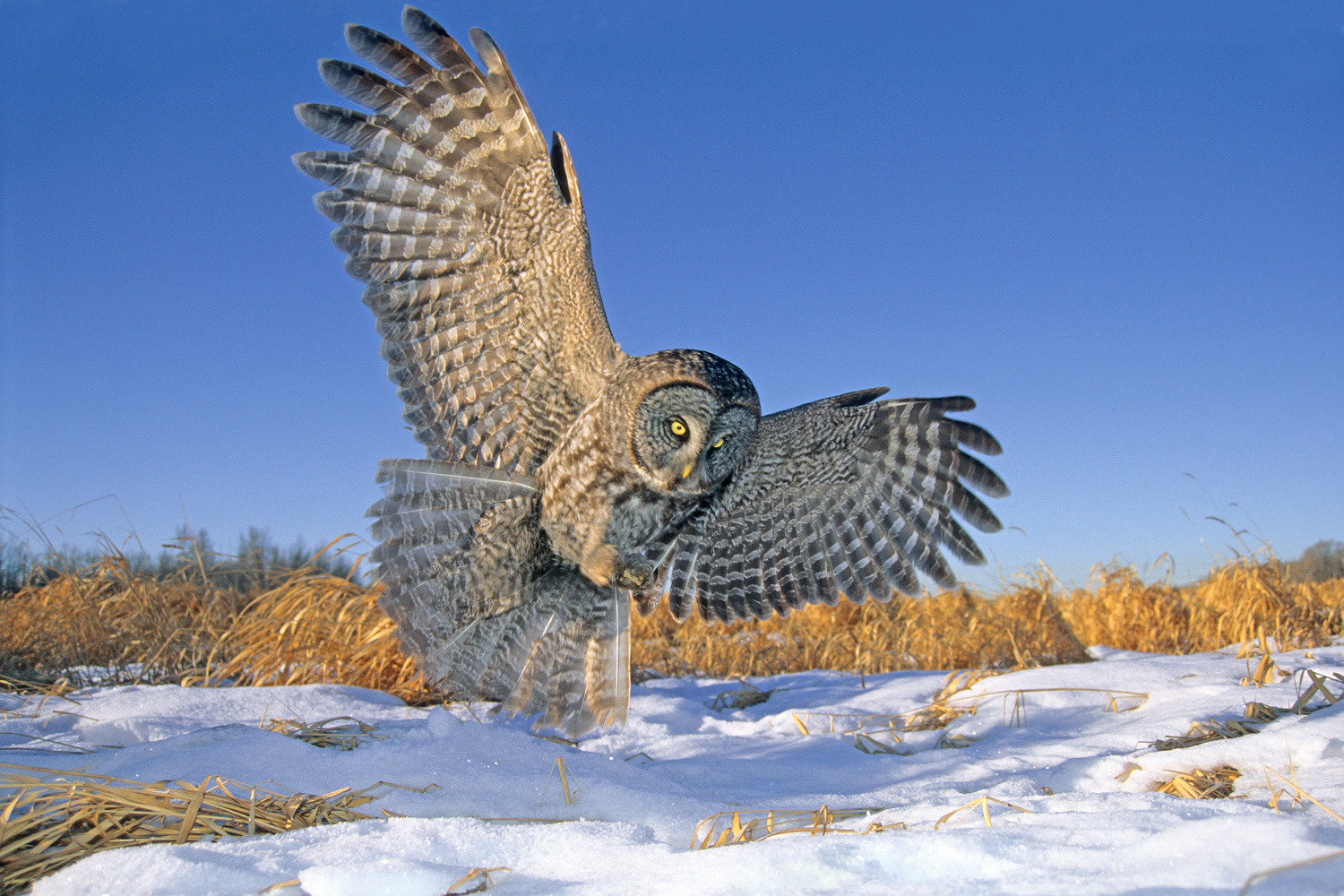In the heart of a remote boreal forest, where the air is crisp and the silence is only broken by the breath of the wind, a deep sense of wildness permeates. It’s a realm where time appears to pause, and the hustle and hassle of the external world momentarily loses its relevance. Surrounded by lofty spruces and a mantle of snow, the presence of a great gray owl embodies an aura that is almost magical. And that is exactly what we experienced on our two great gray owl photo shoots in Canada in March.

Using a working cattle ranch as our base of operations for each trip, we made twice daily forays into distant owl country. We had remarkable success, yielding exceptional images, though our excursions were not devoid of challenges. We had anticipated temperatures around 25 degrees F (-4 degrees C) but were met with an unexpected “heatwave” where the mercury soared to 65 degrees F (18 degrees C) for a few days. During the span of the two tours, we identified seven distinct owls and managed to photograph five of them. The remaining two, which we did not photograph, were situated near busy roads where the risk from passing logging trucks posed potential hazards for both us and the birds. The hazard for the birds from logging is another story.

You would think a search for what is arguably the world’s largest owl (by dimensions, not weight) would be relatively easy? Far from it. These spectacular birds with their silvery gray plumage with brown barring and cryptic streaking make them masters of camouflage melding in perfectly with the background. The reason this trip is so productive is due to the advance groundwork of our local guide who spent days pre-scouting this trip, staking out possible territories of the birds we would return to repeatedly. Due to their remoteness it is unlikely these birds have ever encountered a human or would likely do so again.
One female was undoubtedly the star of the show. Females are readily recognizable due to their large size (males are smaller and do not weigh as much). And she was undeniably unwary around humans. She would routinely sit at the edge of an open forest meadow created by the Alberta petroleum industry. Often, she would sit in one spot for 15 to 20 minutes attentively hunting from a listening post like a low branch or a fence post before “snow plunging” through crusted snow and grabbing a meadow vole in its snowy tunnel without ever seeing it. Her hearing is superb, and her huge facial disk is the key to her success as it directs even the almost imperceptible sounds to her asymmetric ears to triangulate the location of snow-hidden prey.

During the first week of photo shoots, we found her every day. For that tour she was in an oil well clearing that was surrounded by white spruce. The clearing was snowy and made for a nice background although the trees were snow free. Following that trip, on the “turn around” day when I drove back to Edmonton to meet my second group, the temperature started to climb. It got very warm, and the snow had all but disappeared. When we arrived at the clearing that she had been using to hunt voles under the snow, it was flooded with water from the melted snow. There were now no voles to hunt there. We could not find her for an entire day.
We returned the next morning—no luck! The dirt road into the forest was muddy, slushy, and slippery. As I was concentrating on the driving, Bob Cook in a rear seat hollered “there’s an owl!” I had missed it and sure enough there was THE bird. She had moved to a drier meadow to continue her hunts. Snow was gone but we did see her dive into the tall grass and come up with a successful catch. This meadow was very different than where she had been—this one surrounded by leafless aspens—and the look of the images we created on this trip were strikingly dissimilar from the previous trip.

Then luck was on our side and the temperature dropped back into the normal range of about 25 degrees F (-4C). The roads froze making driving easier and it began to snow. On that last day our wish had come true! We found and photographed three owls (including the wonderfully unwary female still in the same meadow) and it was snowing. We couldn’t have asked for more!
Our Great Gray Owls of the North Woods trip is truly a one-of-a-kind photographic journey that produces stunning visuals of a subject that remains a challenging feat for many photographers.
Some great gray owl facts: Strix nebulosa
Great gray owls are the world’s largest owls by length.
They are found in boreal forests throughout the Northern Hemisphere.
They are the only member of the genus Strix found in both the Eastern and Western Hemispheres.
Average weight 2.84 pounds for females and 2.2 pounds for males. The males are usually smaller than females, as with most owl species.
Great grey owls do not build nests, so they typically use nests previously used by a large raptor or the top of a large snapped off tree.
Females lay up to four eggs and incubation is about 30 days.
Great grays rely heavily on small rodents as their main prey but will occasionally eat squirrels, hares, moles, shrews, birds, frogs, and beetles.
Being cryptically colored, great gray owls often remain still for long periods even if a human is nearby—and they are often overlooked or go unnoticed.



